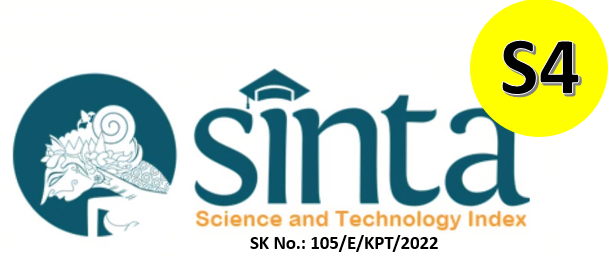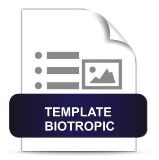The Ability of Secondary Metabolites from Actinomadura sp. as COVID-19 Protease Inhibitor: In Silico Method
DOI:
https://doi.org/10.29080/biotropic.v7i2.1926Keywords:
Keywords: COVID-19 Protease, Actinomadura, Molecular DockingAbstract
The pandemic of COVID-19 disease in the late of 2019 resulted in the massive screening for drug discovery purpose. However, there is still no reports about the ability of natural products from bacterial group of class Actinobacteria as COVID-19 inhibitor. The aim of this research is to identify the potential ability of natural compounds from Actinomadura sp., the member of class Actinobacteria, against two receptors of COVID-19 protease with PDB ID 6LU7 and 5R7Y. The eleven natural compounds were docked using AutoDock Vina and the interaction between receptor and ligands were analysed using LIGPLOT. The most potential compound was simulated for its interaction stability using Yet Another Scientific Artificial Reality Application (YASARA) dynamics. The result of molecular docking by AutoDock Vina showed that Sagamilactam become the most potential inhibitor for viral protease as it had lower binding affinity (6LU7:-12 and 5R7Y:-10.4) compared to the both of native ligand (6LU7:-11.4 and 5R7Y:-4.6). Furthermore, the interaction of the most potential ligand showed the low number of Root Mean Square Deviation (RMSD) deviation in molecular dynamic simulations. This result validated the docking method that used and indicated that secondary metabolites produced from rare actinobacteria of Actinomadura sp. have promising possibility to inhibit COVID-19 protease.
Downloads
References
Aier, I., Varadwaj, P. K., & Raj, U. 2016. Structural insights into conformational stability of both wild-type and mutant EZH2 receptor. Scientific Reports, 6. https://doi.org/10.1038/srep34984
Al-Karmalawy, A. A., Dahab, M. A., Metwaly, A. M., Elhady, S. S., Elkaeed, E. B., Eissa, I. H., & Darwish, K. M. 2021. Molecular Docking and Dynamics Simulation Revealed the Potential Inhibitory Activity of ACEIs Against SARS-CoV-2 Targeting the hACE2 Receptor. Frontiers in Chemistry, 9. https://doi.org/10.3389/fchem.2021.661230
Amin, D. H., Abdallah, N. A., Abolmaaty, A., Tolba, S., & Wellington, E. M. H. 2020. Microbiological and molecular insights on rare Actinobacteria harboring bioactive prospective. Bulletin of the National Research Centre, 44(1). https://doi.org/10.1186/s42269-019-0266-8
Azman, A. S., Othman, I., Velu, S. S., Chan, K. G., & Lee, L. H. 2015. Mangrove rare actinobacteria: Taxonomy, natural compound, and discovery of bioactivity. In Frontiers in Microbiology (Vol. 6, Issue AUG). Frontiers Media S.A. https://doi.org/10.3389/fmicb.2015.00856
Badji, B., Zitouni, A., Mathieu, F., Lebrihi, A., & Sabaou, N. 2006. Antimicrobial compounds produced by Actinomadura sp. AC104 isolated from an Algerian Saharan soil. Canadian Journal of Microbiology, 52(4), 373–382. https://doi.org/10.1139/W05-132
Case, D. A., Cheatham Iii, T. E., Darden, T., Gohlke, H., Luo, R., Merz, K. M., Onufriev, A., Simmerling, C., Wang, B., & Woods, R. J. 2015. The Amber Biomolecular Simulation Programs. http://amber.scripps.edu.
Ding, T., Yang, L. J., Zhang, W. D., & Shen, Y. H. 2019. The secondary metabolites of rare actinomycetes: Chemistry and bioactivity. In RSC Advances (Vol. 9, Issue 38, pp. 21964–21988). Royal Society of Chemistry. https://doi.org/10.1039/c9ra03579f
Feikin, D. R., Higdon, M. M., Abu-Raddad, L. J., Andrews, N., Araos, R., Goldberg, Y., Groome, M. J., Huppert, A., O’Brien, K. L., Smith, P. G., Wilder-Smith, A., Zeger, S., Deloria Knoll, M., & Patel, M. K. 2022. Duration of effectiveness of vaccines against SARS-CoV-2 infection and COVID-19 disease: results of a systematic review and meta-regression. The Lancet, 399(10328), 924–944. https://doi.org/10.1016/S0140-6736(22)00152-0
Glaser, J., Sedova, A., Galanie, S., Kneller, D. W., Davidson, R. B., Maradzike, E., del Galdo, S., Labbé, A., Hsu, D. J., Agarwal, R., Bykov, D., Tharrington, A., Parks, J. M., Smith, D. M. A., Daidone, I., Coates, L., Kovalevsky, A., & Smith, J. C. 2022. Hit Expansion of a Noncovalent SARS-CoV-2 Main Protease Inhibitor. ACS Pharmacology and Translational Science, 5(4), 255–265. https://doi.org/10.1021/acsptsci.2c00026
Huff, S., Kummetha, I. R., Tiwari, S. K., Huante, M. B., Clark, A. E., Wang, S., Bray, W., Smith, D., Carlin, A. F., Endsley, M., & Rana, T. M. 2022. Discovery and Mechanism of SARS-CoV-2 Main Protease Inhibitors. Journal of Medicinal Chemistry, 65(4), 2866–2879. https://doi.org/10.1021/acs.jmedchem.1c00566
Ivanović, V., Rančić, M., Arsić, B., & Pavlović, A. 2020. Lipinski’s rule of five, famous extensions and famous exceptions. In POPULAR SCIENTIFIC ARTICLE (Vol. 3, Issue 1).
Kimura, T., Iwatsuki, M., Asami, Y., Ishiyama, A., Hokari, R., Otoguro, K., Matsumoto, A., Sato, N., Shiomi, K., Takahashi, Y., Omura, S., & Nakashima, T. 2016. Anti-trypanosomal compound, sagamilactam, a new polyene macrocyclic lactam from Actinomadura sp. K13-0306. Journal of Antibiotics, 69(11), 818–824. https://doi.org/10.1038/ja.2016.28
Kony, D. B., Hünenberger, P. H., & van Gunsteren, W. F. 2007. Molecular dynamics simulations of the native and partially folded states of ubiquitin: Influence of methanol cosolvent, pH, and temperature on the protein structure and dynamics. Protein Science, 16(6), 1101–1118. https://doi.org/10.1110/ps.062323407
Krieger, E., & Vriend, G. 2015. New ways to boost molecular dynamics simulations. Journal of Computational Chemistry, 36(13), 996–1007. https://doi.org/10.1002/jcc.23899
Kusumaningrum, H. P., Ferniah, R. S., Jannah, S. N., Kurniawati, M. B., Afifah, A., Sumbodo, Y. M., Hanif, S. S., Erfianti, T., & Eshananda, Y. 2022. Relationship Between Phylogenetic of Apium and Foeniculum Plants from Central Java, Indonesia, and Their Secondary Metabolites Potency against COVID-19 Protease. Open Access Macedonian Journal of Medical Sciences, 10(A), 1234–1241. https://doi.org/10.3889/oamjms.2022.9852
Lipinski, C. A. 2004. Lead- and drug-like compounds: The rule-of-five revolution. In Drug Discovery Today: Technologies (Vol. 1, Issue 4, pp. 337–341). https://doi.org/10.1016/j.ddtec.2004.11.007
Morris, G. M., Ruth, H., Lindstrom, W., Sanner, M. F., Belew, R. K., Goodsell, D. S., & Olson, A. J. 2009. Software news and updates AutoDock4 and AutoDockTools4: Automated docking with selective receptor flexibility. Journal of Computational Chemistry, 30(16), 2785–2791. https://doi.org/10.1002/jcc.21256
Puttaswamy, H., Gowtham, H. G., Ojha, M. D., Yadav, A., Choudhir, G., Raguraman, V., Kongkham, B., Selvaraju, K., Shareef, S., Gehlot, P., Ahamed, F., & Chauhan, L. 2020. In silico studies evidenced the role of structurally diverse plant secondary metabolites in reducing SARS-CoV-2 pathogenesis. Scientific Reports, 10(1). https://doi.org/10.1038/s41598-020-77602-0
Ramadhan, D. S. F., Fakih, T. M., & Arfan, A. 2020. Activity Prediction of Bioactive Compounds Contained in Etlingera elatior Against the SARS-CoV-2 Main Protease: An In Silico Approach. Borneo Journal of Pharmacy, 3(4), 235–242. https://doi.org/10.33084/bjop.v3i4.1634
Singhal, T. 2020. A Review of Coronavirus Disease-2019 (COVID-19). In Indian Journal of Pediatrics (Vol. 87, Issue 4, pp. 281–286). Springer. https://doi.org/10.1007/s12098-020-03263-6
Tarantini, F. S., Brunati, M., Taravella, A., Carrano, L., Parenti, F., Hong, K. W., Williams, P., Chan, K. G., Heeb, S., & Chan, W. C. 2021. Actinomadura graeca sp. nov.: A novel producer of the macrocyclic antibiotic zelkovamycin. PLoS ONE, 16(11). https://doi.org/10.1371/journal.pone.0260413
Trott, O., & Olson, A. J. 2009. AutoDock Vina: Improving the speed and accuracy of docking with a new scoring function, efficient optimization, and multithreading. Journal of Computational Chemistry, NA-NA. https://doi.org/10.1002/jcc.21334
Xue, Q., Liu, X., Russell, P., Li, J., Pan, W., Fu, J., & Zhang, A. 2022. Evaluation of the binding performance of flavonoids to estrogen receptor alpha by Autodock, Autodock Vina and Surflex-Dock. Ecotoxicology and Environmental Safety, 233. https://doi.org/10.1016/j.ecoenv.2022.113323
Zeiger, E. 2019. The test that changed the world: The Ames test and the regulation of chemicals. In Mutation Research - Genetic Toxicology and Environmental Mutagenesis (Vol. 841, pp. 43–48). Elsevier B.V. https://doi.org/10.1016/j.mrgentox.2019.05.007
Zhang, L., Lin, D., Sun, X., Curth, U., Drosten, C., Sauerhering, L., Becker, S., Rox, K., & Hilgenfeld, R. 2020. Crystal structure of SARS-CoV-2 main protease provides a basis for design of improved a-ketoamide inhibitors. Science, 368(6489), 409–412. https://doi.org/10.1126/science.abb3405
Downloads
Published
How to Cite
Issue
Section
License
Copyright (c) 2023 Yuriza Eshananda, Sri Martina Wiraswati, Sri Lestari, Afifah Mariana, Tia Erfianti, Hermin Pancasakti Kusumaningrum

This work is licensed under a Creative Commons Attribution-NonCommercial-ShareAlike 4.0 International License.













